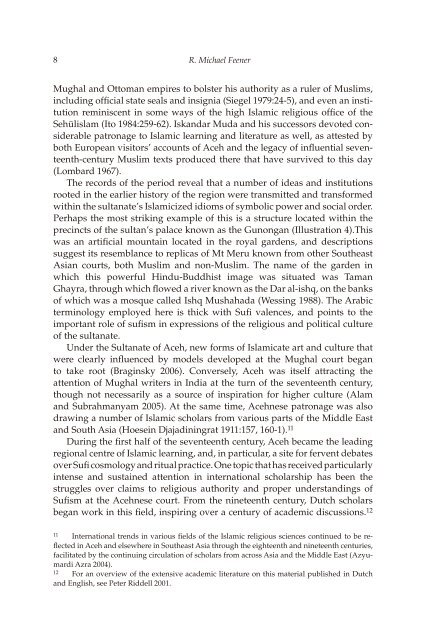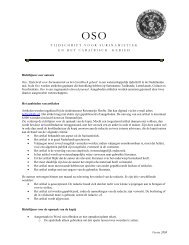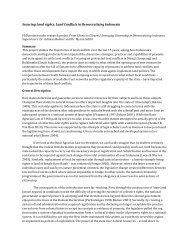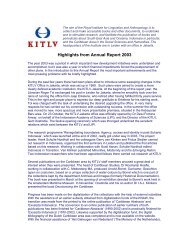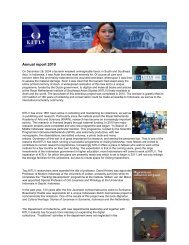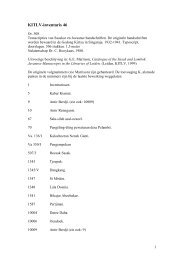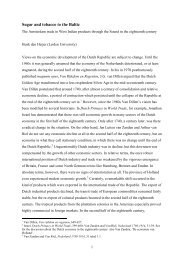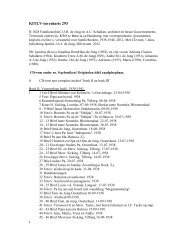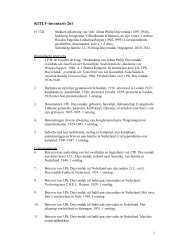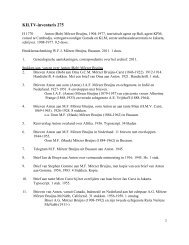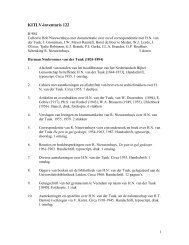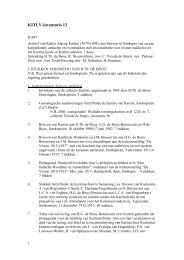The Acehnese past and its present state of study R. Michael ... - kitlv
The Acehnese past and its present state of study R. Michael ... - kitlv
The Acehnese past and its present state of study R. Michael ... - kitlv
You also want an ePaper? Increase the reach of your titles
YUMPU automatically turns print PDFs into web optimized ePapers that Google loves.
8 R. <strong>Michael</strong> Feener<br />
Mughal <strong>and</strong> Ottoman empires to bolster his authority as a ruler <strong>of</strong> Muslims,<br />
including <strong>of</strong>fi cial <strong>state</strong> seals <strong>and</strong> insignia (Siegel 1979:24-5), <strong>and</strong> even an institution<br />
reminiscent in some ways <strong>of</strong> the high Islamic religious <strong>of</strong>fi ce <strong>of</strong> the<br />
Sehülislam (Ito 1984:259-62). Isk<strong>and</strong>ar Muda <strong>and</strong> his successors devoted considerable<br />
patronage to Islamic learning <strong>and</strong> literature as well, as attested by<br />
both European visitors’ accounts <strong>of</strong> Aceh <strong>and</strong> the legacy <strong>of</strong> infl uential seventeenth-century<br />
Muslim texts produced there that have survived to this day<br />
(Lombard 1967).<br />
<strong>The</strong> records <strong>of</strong> the period reveal that a number <strong>of</strong> ideas <strong>and</strong> institutions<br />
rooted in the earlier history <strong>of</strong> the region were transmitted <strong>and</strong> transformed<br />
within the sultanate’s Islamicized idioms <strong>of</strong> symbolic power <strong>and</strong> social order.<br />
Perhaps the most striking example <strong>of</strong> this is a structure located within the<br />
precincts <strong>of</strong> the sultan’s palace known as the Gunongan (Illustration 4).This<br />
was an artifi cial mountain located in the royal gardens, <strong>and</strong> descriptions<br />
suggest <strong>its</strong> resemblance to replicas <strong>of</strong> Mt Meru known from other Southeast<br />
Asian courts, both Muslim <strong>and</strong> non-Muslim. <strong>The</strong> name <strong>of</strong> the garden in<br />
which this powerful Hindu-Buddhist image was situated was Taman<br />
Ghayra, through which fl owed a river known as the Dar al-ishq, on the banks<br />
<strong>of</strong> which was a mosque called Ishq Mushahada (Wessing 1988). <strong>The</strong> Arabic<br />
terminology employed here is thick with Sufi valences, <strong>and</strong> points to the<br />
important role <strong>of</strong> sufi sm in expressions <strong>of</strong> the religious <strong>and</strong> political culture<br />
<strong>of</strong> the sultanate.<br />
Under the Sultanate <strong>of</strong> Aceh, new forms <strong>of</strong> Islamicate art <strong>and</strong> culture that<br />
were clearly infl uenced by models developed at the Mughal court began<br />
to take root (Braginsky 2006). Conversely, Aceh was <strong>its</strong>elf attracting the<br />
attention <strong>of</strong> Mughal writers in India at the turn <strong>of</strong> the seventeenth century,<br />
though not necessarily as a source <strong>of</strong> inspiration for higher culture (Alam<br />
<strong>and</strong> Subrahmanyam 2005). At the same time, <strong>Acehnese</strong> patronage was also<br />
drawing a number <strong>of</strong> Islamic scholars from various parts <strong>of</strong> the Middle East<br />
<strong>and</strong> South Asia (Hoesein Djajadiningrat 1911:157, 160-1). 11<br />
During the fi rst half <strong>of</strong> the seventeenth century, Aceh became the leading<br />
regional centre <strong>of</strong> Islamic learning, <strong>and</strong>, in particular, a site for fervent debates<br />
over Sufi cosmology <strong>and</strong> ritual practice. One topic that has received particularly<br />
intense <strong>and</strong> sustained attention in international scholarship has been the<br />
struggles over claims to religious authority <strong>and</strong> proper underst<strong>and</strong>ings <strong>of</strong><br />
Sufi sm at the <strong>Acehnese</strong> court. From the nineteenth century, Dutch scholars<br />
began work in this fi eld, inspiring over a century <strong>of</strong> academic discussions. 12<br />
11 International trends in various fi elds <strong>of</strong> the Islamic religious sciences continued to be refl<br />
ected in Aceh <strong>and</strong> elsewhere in Southeast Asia through the eighteenth <strong>and</strong> nineteenth centuries,<br />
facilitated by the continuing circulation <strong>of</strong> scholars from across Asia <strong>and</strong> the Middle East (Azyumardi<br />
Azra 2004).<br />
12 For an overview <strong>of</strong> the extensive academic literature on this material published in Dutch<br />
<strong>and</strong> English, see Peter Riddell 2001.


